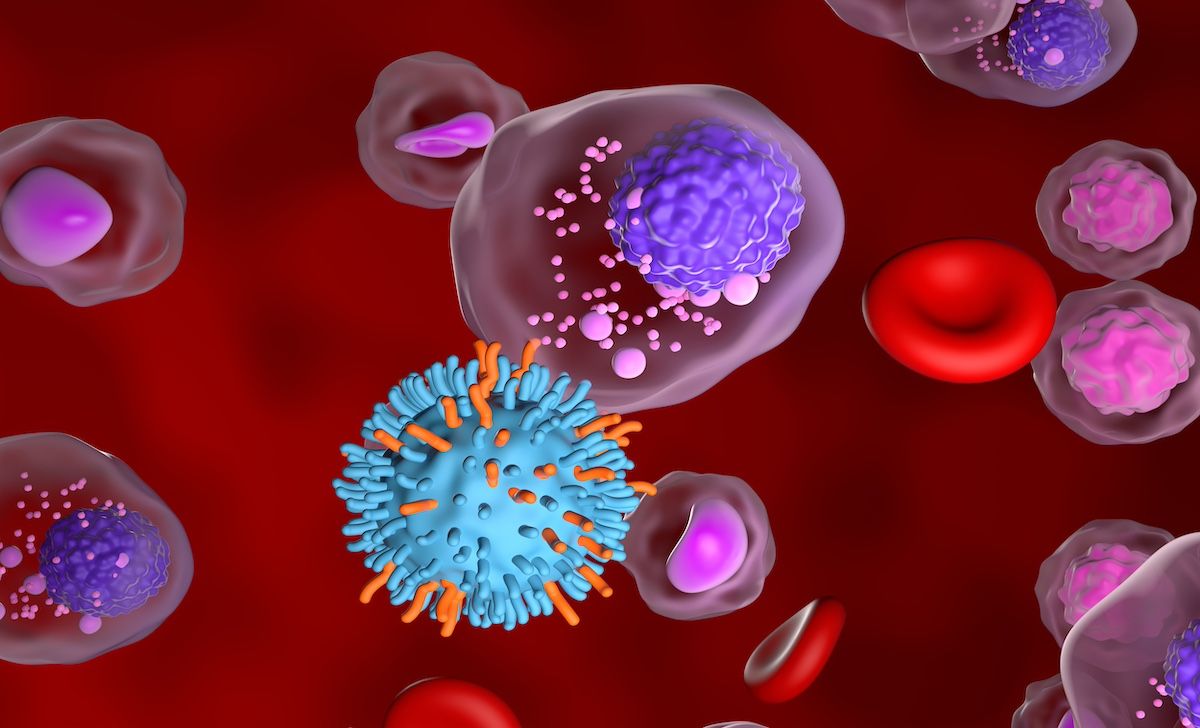- Center on Health Equity & Access
- Clinical
- Health Care Cost
- Health Care Delivery
- Insurance
- Policy
- Technology
- Value-Based Care
Dual-Target CAR T Cells Achieve 100% Response Rate in MM
This new analysis examined the investigational chimeric antigen receptor (CAR) T-cell therapy GC012F among patients with newly diagnosed and high-risk multiple myeloma (MM).
The investigational chimeric antigen receptor T-cell therapy (CAR T) GC012F has been shown safe in a new single-arm open-label phase 1 cohort analysis conducted between 2021 and 2023 among 22 patients with newly diagnosed high-risk multiple myeloma. Patients exhibited a rapid response to the treatment, with few adverse effects (AEs) and no instances of neurotoxicity following 1 of 3 infusions: 1 x 105 cells/kg, 2 x 105 cells/kg, or 3 x 105 cells/kg).
Approximately 15% to 20% of patients who have multiple myeloma are considered high risk1; features of this subtype of the hematological cancer include plasma cell leukemia, extramedullary disease, renal failure, frailty,2 and cytogenetic abnormalities that include t(4;14), del(17/17p), t(14;16), t(14;20), nonhyperdiploidy, and gain(1q).3
Investigators published their findings online today in JAMA Oncology of their dual-target approach against B-cell maturation antigen (BCMA) and CD19.4 Their primary end points were AEs, overall response rate (ORR), complete response rate (CR), stringent CR (sCR), minimal residual disease (MRD) negativity rate, duration of response (DOR), and progression-free survival (PFS).
The CAR T investigated in this analysis targeted both B-cell maturation antigen and CD19 | Image Credit: LASZLO-stock.adobe.com

“The absence of a standardized definition for high-risk multiple myeloma has hindered the identification of an optimal treatment approach,” the authors wrote, speaking to the importance of their investigation. “Relapses remain frequent. Hence, the simultaneous targeting of different surface antigens of BCMA and CD19 is an effective strategy to prevent relapse.”
The full study population was 26 patients (median age, 59 years [range, 43-69]), and 63% were male patients; 22 were infused following lymphodepletion with fludarabine and cyclophosphamide. Investigator discretion at month 6 determined if patients could be maintained on lenalidomide. Nineteen patients were included in the safety follow-up at a median 16 months (range, 3.6-23.6).
The median time since multiple myeloma diagnosis ranged from 3.6 months to 4.7 months.
Although there was no neurotoxicity, patients still experienced 3 common AEs of grade 3 or higher: lymphopenia (64%), leukopenia (45%), and neutropenia (41%). The top 3 nonhematologic AEs, all grade 1 or 2, were increased lactate dehydrogenase (41%), hypocalcemia (41%), and hypoalbuminemia (41%).
There were no cases of treatment-related tumor lysis syndrome, and the median duration of cytokine release syndrome was 1 day (range, 1-4). Median time to onset of cytokine release syndrome was 7 days (range, 6-9).
The ORR was 100%, and all patients in the safety analysis experienced the best response of sCR, including MRD-negativity status at 1, 6, and 12 months after infusion. Median times to first of each were 84 days (range, 26-267) and 28 days (range, 23-135), respectively. Median DOR, PFS, and OS have not yet been reached.
Median peak copy number (Cmax) of GC012F was 60,652 copies/μg genomic DNA (range, 8754-331 159 copies/μg genomic DNA), and the median time to this reading was 10 days (range, 9-14). The median persistence was 29 days (range, 26-196), and median area under the curve, 289,685 (range, 80,131-985,420). There were no observed differences correlated with dose (P = .77), nor was expansion of GC012F—seen in 22 patients—linked to DOR, PFS, and OS.
Patients whose cytokine release syndrome (CRS) was treated had a higher Cmax compared with patients who had untreated CRS or no CRS:
- Treated CRS: 137,404 copies/μg genomic DNA
- Untreated CRS: 30,691 copies/μg genomic DNA (P = .01)
- No CRS: 62,131 copies/μg genomic DNA (P = .04)
A single patient experienced disease progression, as evidenced by a rib mass.
The authors believe additional larger studies are warranted, due to their small patient population and relatively short follow-up. In particular, they suggest that GC012F be investigated as an early intervention following induction.
References
1. Krishnan A. How to think about risk in myeloma. City of Hope. Accessed July 24, 2024. https://www.cityofhope.org/sites/www/files/2022-06/1430440207327-wcc_074208.pdf
2. Caro J, Al Hadidi S, Usmani S, Yee AJ, Raje N, Davies FE. How to treat high-risk myeloma at diagnosis and relapse. Am Soc Clin Oncol Educ Book. 2021:41:291-309. doi:10.1200/EDBK_320105
3. Treatment of multiple myeloma with high-risk cytogenetics: a consensus of the International Myeloma Working Group. International Myeloma Foundation. Accessed July 24, 2024. https://www.myeloma.org/resource-library/treatment-multiple-myeloma-high-risk-cytogenetics-consensus-international-myeloma
4. Qiang W, Lu J, Jia Y, et al. B-Cell maturation antigen/CD19 dual-targeting immunotherapy in newly diagnosed multiple myeloma. JAMA Oncol. Published online July 25, 2024. doi:10.1001/jamaoncol.2024.2172
